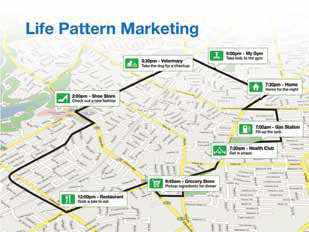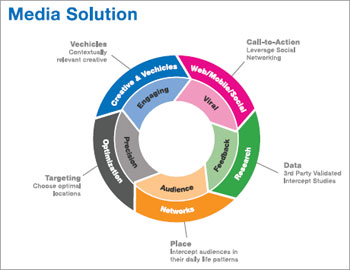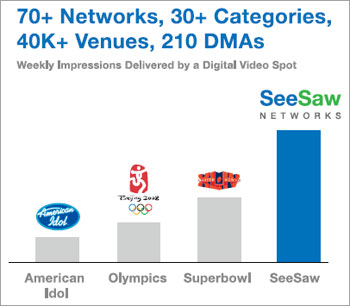BRIDGING THE CHASM

The economies of scale are here, now, for the true Place-Based media network
What will the future of digital place-based media (DPM) be like? The simple answer to this question is that it will be like TV — but with no remote control and no DVR, and, therefore, a very important addition to the media mix.
DPM is already often programmed like TV. It offers creative vehicles for advertising like TV. It will be measured like TV. And it will be planned like TV — but with the opportunity to “engage” consumers considering a purchase and “activate” consumers on the path to purchase.
PLANNING AHEAD

A variety of demand side platforms (DSPs) for place-based media are available that allow you to find and measure inventory. But SeeSaw developed a platform to optimize campaigns with precision targeting, not just find any available inventory. Optimization allows agencies and advertisers to precisely target an audience across geographies, places, and demographics.
TV advertising is planned in advance. This allows advertisers to properly select the shows they desire, to provide predictability and transparency of audience reach, and to ensure ads are appropriate given the show. Similarly, place-based media venue owners are incredibly sensitive about the experience the consumer has in their venues. For example, doctors don’t want unhealthy products advertised in their waiting rooms and retailers don’t want to show products that compete with those sold in their stores. Therefore, place-based media is planned in advance like TV.
In contrast, online display, search, and video advertising uses a pull model of advertising where an available advertising spot on a publisher’s site requests an ad from an ad server in real-time, with no human in the loop. Some techies claim that exception rules can filter out certain undesirable advertisers and creative content. But even if the technology for describing advertisers and creative treatments were granular enough to recognize undesirable ads, most venue hosts will simply not “trust” it. It’s simply different to be a publisher on the web than owning bricks and mortar that people go “in” and experience.
A daily selection of the top stories for AV integrators, resellers and consultants. Sign up below.
BEING DIGITAL
This may sound limiting, but it’s not. Advertisers can still leverage the digital nature of the media to customize the content to each and every screen. Advertising can vary dynamically based on location, day-part, weather, game scores, traffic, or any other parameter. For example, beverage companies can swap their ads on sweltering hot days to frosty photos of their product to stimulate interest and consumption.
So, in a nutshell, DPM is most certainly digital. It’s real-time. But it will be planned ahead of time so that everyone is comfortable with where and when the ad airs. This will make the experience much better for the consumer compared to the clutter or invasive targeting you experience on the web.
PROGRAMMING
What is the typical digital place-based media experience today and where is it going? Today, we often experience news feeds, weather, and sports playing in venues. But the media is maturing quickly. Full video productions are more prevalent in both programming content and ad creative. For example, there are health shows in doctor offices, extreme sports shows and music videos in hip retail stores, fashion productions in stylish retail locations, and cooking shows in grocery stores. But this is just the start. Soon there will be shows like dramas, comedies, talk shows, and reality shows with recognized talent, produced specifically for this medium. These will be 2- to 10-minute productions, tailored for specific venues. Talent agencies will love the new channel of exposure for their clients. Networks will love how the engaging content impacts audience measurements. And finally the consumer will love being truly entertained and informed with highquality productions versus undifferentiated news feeds.
Many argue this kind of production quality is not economically viable. That may have been true in the past, but the industry is finally at scale. For example, SeeSaw delivers 150M weekly impressions at 50K locations across 40 different kinds of places. When a production airs at 20K locations, across 20 kinds of venues and reaches 20M women, the economics work. Networks and locations will avoid significant production costs and instead license productions. Moreover, the improved consumer experience and viewership stimulated by original, targeted content will generate higher advertising revenues.

Digital place-based media (DPM) is already often programmed like TV. It offers creative vehicles for advertising like TV. It will be measured like TV. And it will be planned like TV — but with the opportunity to “engage” consumers considering a purchase and “activate” consumers on the path to purchase.
But what does this mean for advertisers? It means they will now have all the creative vehicles TV offers. Sure, there are the standard 15- and 30-second spots typically aired, but now there are significant brand integration opportunities. What ingredients are used on the cooking show? What is the band wearing on the “New Music Tuesdays” show? Seamlessly weaving brands into custom programming will change the face of DPM and capture the attention of creative agencies. The cameras are rolling.
MEASUREMENT
If DPM looks like TV, can it be measured like TV, planned like TV, and bought like TV? Let’s start with measurement. The industry has come a long way in a few short years with measurement standards. Back in 2006, when SeeSaw Networks was founded, we were challenged to create a uniform metric across many disparate networks. As a result, we standardized on a gross impression defined as traffic in a venue, times a third-party validated awareness factor that considers only those who are aware of the screen. Last year, the Digital Placed-based Advertising Association furthered the definition of a gross impression by including factors like ad rotation and the length of a programming loop. Now SeeSaw and others are taking the next step in measurement by creating models of reach and frequency. As we develop the methodology for determining reach, networks, who are measured by vendors like Nielsen, will soon be able to combine their metrics to determine the reach of life pattern plans — plans that intercept people at many different places in their daily routines. Given the current scale of the industry, life pattern plans can now reach audiences larger than prime time spots. As we incorporate reach and frequency models into the planning process, planners will be able to trade-off investments in digital placebased media versus other media like television to optimize the media mix.

The Place-Based Media Industry is finally at scale. For example, SeeSaw, for example, delivers 150M weekly impressions at 50K locations across 40 different kinds of places.
PLANNING
Planning DPM is already a science. A variety of demand side platforms (DSPs) for place-based media are available that allow you to find and measure inventory. But when SeeSaw created the SeeSawAds.com DSP in 2006, we sought to take planning to the next level. We developed a platform to optimize campaigns with precision targeting, not just find any available inventory. Optimization allows agencies and advertisers to precisely target an audience across geographies, places, and demographics. This intelligent technology is unique in that it selects the specific locations that best meet the optimization criteria. In contrast, traditional planning methods select or reject entire categories of venues or geographic areas, resulting in inefficient plans. For example, in planning a highly targeted campaign for moms (e.g., W 18-54), an optimizer selects individual locations that index over a specified level (e.g., 150) for moms while meeting the budget criteria and omits locations below the index threshold. With this technology, planners can run what-if scenarios and compare and contrast various tradeoffs. For example, one plan may maximize the precision of reaching an audience, another one may optimize effective reach across markets, and another one may minimize the effective CPM. The planner is empowered to consider multiple options and provide the client with an efficient and effective plan.
The next step in the maturation of DPM planning is the integration of media mix planning systems with DPM optimization platforms. Media mix planning systems will query place-based DSPs via web services to deliver planning scenarios. Planners will then be able to trade-off budget between line items and truly see the incremental reach and precision offered by DPM as compared to other media alternatives. Then, as the media mix is committed, DPM specialists will then use optimizers like SeeSawAds.com to create cost-effective, precise plans.
Monte Zweben (mzweben@seesawnetworks.com)is founder and chairman of the board, SeeSaw Networks. Zweben is a serial entrepreneur with over 20 years of successful start-up experience. Zweben is the co-author of Intelligent Scheduling and has published articles in the Harvard Business Review and various computer science journals and conference proceedings. He serves on the Dean’s advisory board for Carnegie-Mellon University’s School of Computer Science and the board of directors of Rocket Fuel Inc.
